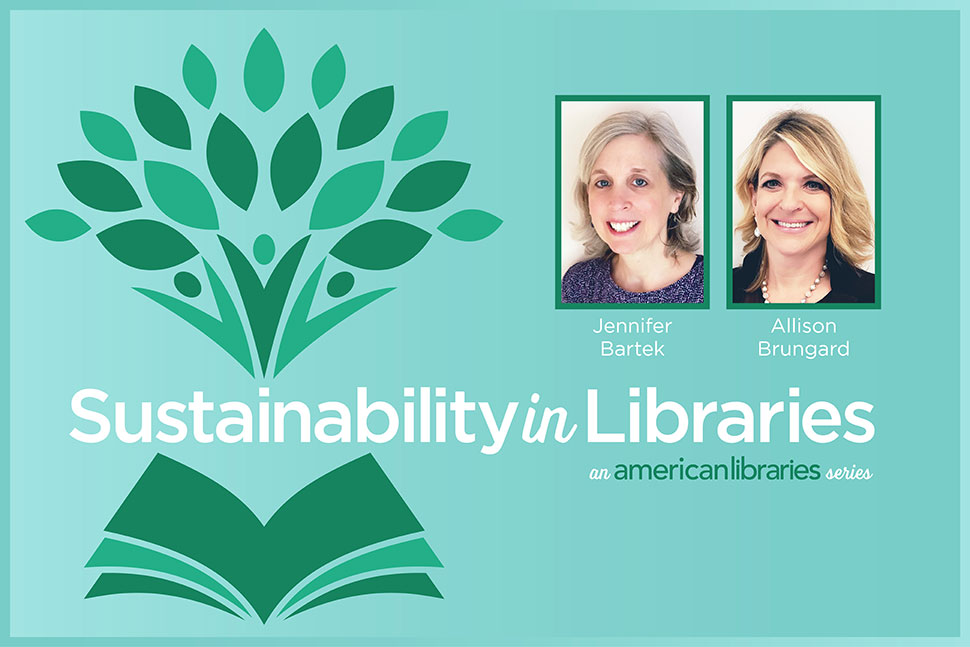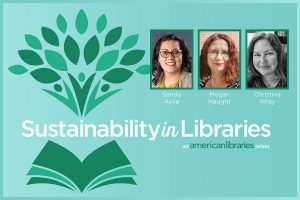
To mark the 50th anniversary of Earth Day—and recognize the American Library Association adding sustainability as a core value—American Libraries returns with its ongoing sustainability series. In these posts, information professionals share their experiences with sustainability in libraries.
Infusing green practices into a library involves little investment, yet yields large returns.
Bailey Library, where we work, is located in the heart of Slippery Rock University’s (SRU) campus in rural western Pennsylvania. Our midsized university has been named a “green college” by education services company The Princeton Review for many years, and the environmental nonprofit Sierra Club considers it a “cool school.”
We lead Bailey Library’s Green Team to model and practice sustainability at SRU. The five-member team includes library staff and faculty and an administrator. Having administrative support is a must for implementing ideas, procuring resources, and making long-term plans.
A library organization acts as its own ecosystem, so it seems natural to improve its health by intentionally reducing its environmental footprint, including reducing waste and saving energy. Long-term strategies are what create a culture of sustainability—not a few one-and-done projects.
Bailey Library was already engaged in sustainable practices. We started with a few small initiatives that grew organically over time. Then we were invited to participate in the Green Leaves self-certification program from the Sustainable Enterprise Accelerator (SEA), a SRU-owned, student-run consulting firm that helps entrepreneurs start and grow sustainable businesses.
The Green Leaves program is adapted from one developed at Harvard University and is used with their permission. This catalyst increased our efforts. We were one of the first units on campus to earn two “leaves.” Each green leaf represents a level earned by integrating sustainable policies and behaviors into office culture. We continue to work with SEA to serve as a model for other departments.
Ongoing green library programs include composting, paper reuse, printing reduction, single-use plastic reduction, and social media campaigns. We have spent some time and resources—to purchase recycling bins, for example—but at a low cost. One of the first things we started was composting. The café housed in the library donates all its used coffee grounds to that effort. Library users and employees compost throughout the building as well, and it has become a talking point on campus tours.
Some initiatives can be as simple as a friendly reminder to bring a reusable cup to a staff meeting. We made a conscious decision not to use a K-Cup beverage machine in the staff lounge and have committed to not accepting plastic water bottles and Styrofoam from vendors for catered events.
Reuse is a key component of any green efforts. We have a designated free-cycle area where others can take gently used office products instead of buying something new. We reuse paper in a few simple yet novel ways. For example, our shredded paper is sent to local animal rescue and zoo facilities for use as animal bedding. Used paper is sent to the childcare center on campus for craft projects, and scrap paper is available throughout the library to jot notes. We offer other easy practical ideas:
- Think about doing more when and where you can, while using less.
- Break the cycle of constant consumption.
- Use eco-friendly and post-consumer products when possible.
- Incorporate energy-saving measures throughout the building, such as automatic lights in the stacks and low-flow toilets.
- Set print defaults to double-sided and encourage others to “think before you print.”
Much of this discussion focuses on the library as a workplace. However, we also promote sustainability through our resources and teaching. We collaborate with various academic departments, including Geography, Geology, and the Environment; Parks, Resource Management, and Conservation; and Public Health. For example, as STEM librarian, Allison is embedded in a course whose students are proposing a sustainability plan for the statewide higher education system, offering innovative ideas, resources, and support.
Sustainability topics are ideal for library instruction sessions. The multidisciplinary aspect aligns with so many areas, from literary eco-criticism to ethics and philosophy to green chemistry and eco-tourism. We also highlight how resources can be sustainable as well, such as open education resources and digital archives.
Efforts have blossomed, and the library now plays a central role in sustainable initiatives on campus. We have created relationships with many campus partners related to educational programs, events, facilities management, and community engagement. Our hope is to inspire other libraries and organizations.
Today’s generation wants to make a difference in their work and their personal lives. The library is one of the largest employers on campus, and our student workers participate in our efforts throughout all areas of library functions—and our users take notice.
Sustainability is part of our vocabulary, and practices are outlined in our strategic plan and exemplified through programming and events such as participation in Earth Days in April and Sustainability Month in October. We continuously generate ideas and strive to do more. Most recently, we incorporated sustainability training as an outcome for new hire orientations.
Want to try this at your library? Start small, and identify the connections that already exist. If there is a community garden nearby, partner on programming, start a seed library, or host a plant exchange. Forward-thinking sustainability efforts and the health of the library eco-system involve employees, library users, and the community at large.
Over the past few years, we have learned that we can act as a conduit, but we cannot impose our beliefs on others. Some truly appreciate the green culture of the library. It feels good to know we are doing something far-reaching.
It takes just a few people to start a ripple that inspires change.


